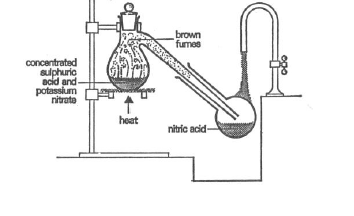(i). Apparatus

(ii). Reagents
- Nitric acid is prepared in the laboratory by action of concentrated sulphuric acid on solid nitrates e.g. potassium nitrate (KNO
3) and sodium nitrate (NaNO
3)
(iii). Procedure
- 30-40 grams of small crystal of KNO
3 are put in a retort flask.
- Concentrated sulphuric acid is added just enough to cover the nitrate; and then heated (warmed) gently.
- The apparatus is all glass.
Reason:
- Nitric (V) acid would attack rubber connections.
- The neck of the retort flask is inserted into a flask that is kept cool continually under running water; this is where nitric acid is collected.
Note:
The cold water running over the collection flask is meant to cool (condense) the hot fumes of nitric (V) acid.
(iv). Observations and explanations
- Fumes of nitric are observed in the retort;
Equation:

- If Lead (II) nitrate was used;

Note: with lead (II) nitrate the reaction soon stops because the insoluble lead (II) sulphate coats the surface of the nitrate preventing further reaction; yield of nitric (V) acid is thus lower;
-These fumes of nitric acid appear brown.
Reason:
- Due to the presence of nitrogen (iv) oxide gas formed by thermal decomposition of nitric acid.
Equation:

- Pure nitric (V) acid is colourless but may appear yellow (brown) due to the presence of Nitrogen (IV) oxide.
- The brown colour can be removed by blowing air through the acid.
- Fuming nitric acid boils at 83
oC and is 99% pure; while concentrated nitric acid is only 70% acid and 30% water.
Note: Nitric acid is usually stored in dark bottles.
Reason:
- To avoid its decomposition by light to nitrogen (IV) oxide, oxygen and water.
- The reaction in the retort flask is a typical displacement reaction; in which the more volatile nitric (V) acid is displaced from nitrates by the less volatile sulphuric acid.
- The nitric acid distills over because it is more volatile than sulphuric acid.
Kavungya answered the question on
March 5, 2019 at 11:07